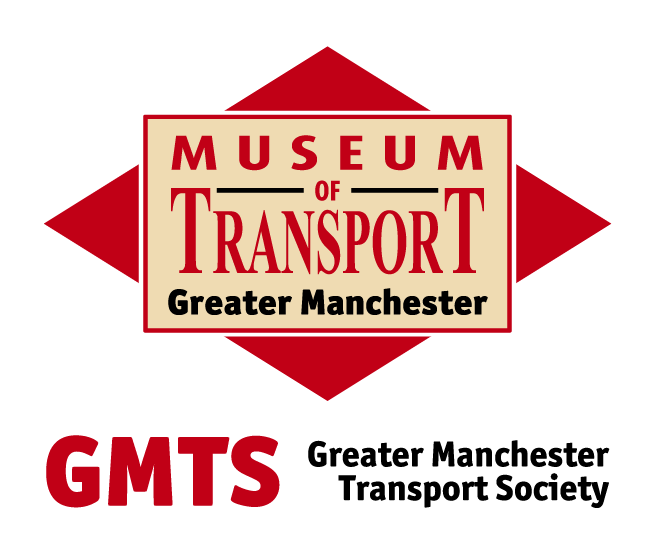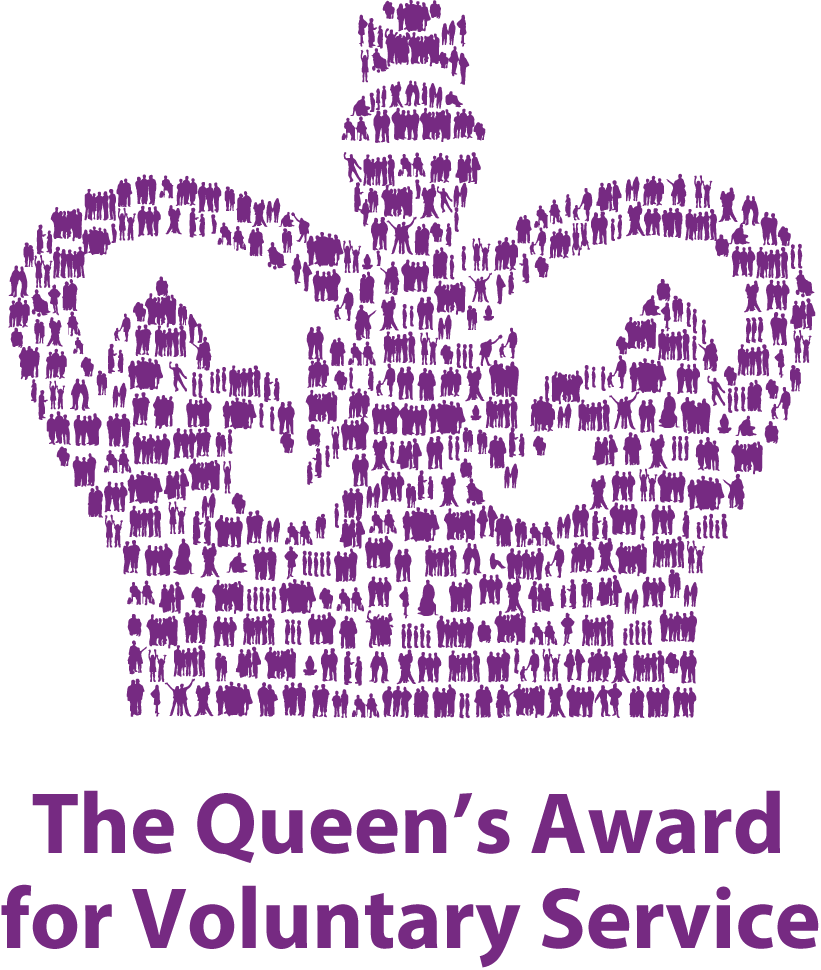1946 Northenden Garage returned to Manchester Corporation by the Ministry of Aircraft Production.
1946 Oldham Corporation’s last tram runs (3 August).
1946 Last conductress works on a Manchester Corporation service (10 November).
Football crowds wait for buses in Manchester Piccadilly on a cleared bomb site, now the location of Piccadilly Plaza
1947 Transport Act 1947: nationalisation of railways and London Passenger Transport Board.
1947 8 ft. wide buses first put into service.
1947 Weekly working hours reduced to 44 by Manchester Corporation.
1947 Bolton Corporation’s last tram runs (29 March).
1947 Last Salford Corporation tram runs (31 March).
1947 Stockport Corporation resumes tramway abandonment.
1948 Transport Act 1947 is implemented: railways are nationalised (January).
1948 Through the Transport Act 1947, North Western is now part owned by the British Transport Commission through its LMS and LNER connections.
1948 Manchester Corporation installs a radio telephone service to provide communication with mobile units engaged on traffic control and emergency repairs.
1948 Electricity generation is nationalised (1 April).
1948 Bolton Corporation’s Howell Croft South Bus Station opens (July).
1948 A Salford bus along with some from other operators carries passengers in Denmark as part of the British Exhibition.
1948 Manchester Corporation first trials an 'Ultimate' ticket machine (11 August)
1948 Wigan Corporation abandons Bell Punch tickets.
1948 Lancashire United Transport and Power Company becomes Lancashire United Transport (25 November). Stalybridge, Hyde, Mossley and Dukinfield Transport and Electricity Board becomes Stalybridge, Hyde, Mossley and Dukinfield Transport Board.
1949 Operation of Manchester Corporation's last tram (10 January).
1949 Bury Corporation runs its last tram (13 February).
1949 Record number of passengers carried by Manchester Corporation: 492,417,219.
1949 Manchester Corporation introduces ‘Ultimate’ ticket machines.
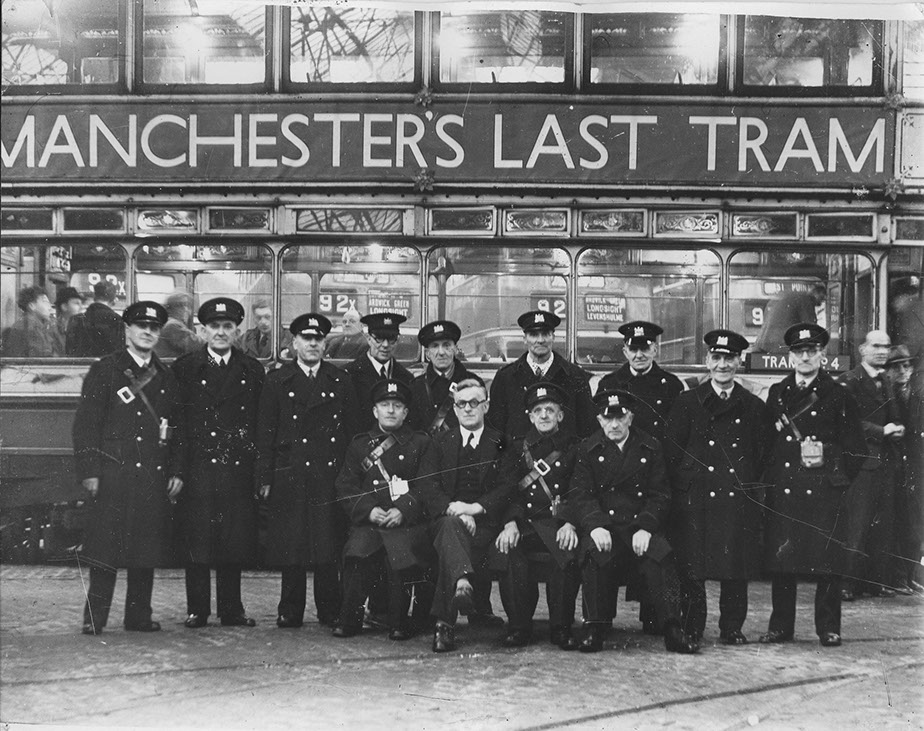
Drivers and conductors of the last four Manchester Corporation trams, seen in Birchfields Road Depot (10 January 1949)

Manchester Piccadilly looking towards Market Street as evening rush hour starts
1950 Last extension to Manchester Corporation’s trolleybus system.
1950 Manchester Corporation introduces exterior advertising on its buses for the first time to raise revenue.
1950 Ramsbottom UDC pioneers Leyland’s first underfloor buses, taking four out of the 12 vehicles made.
1950 Wigan Corporation introduces its first highbridge double deck buses.
1950 Ashton-under-Lyne Corporation introduces 'Ultimate' ticket machines (31 May).
1950 Oldham Corporation introduces 'Ultimate' ticket machines (4 October).
1950 Leigh Corporation trials two 'Ultimate' ticket machines for one month (16 November).
1951 Last Stockport Corporation tram operates, the last tram service in Greater Manchester (25 August).
1951 Mechanical bus washing machines are installed for the first time.
1951 A Mayne & Son introduces 'Ultimate' ticket machines (14 September).
1951 Manchester Corporation stops using Bell Punch tickets.
1953 The first of Manchester Corporation’s trolleybus routes is withdrawn.
1953 Manchester Corporation introduces a new fleet of Airport buses and introduces City Tours.
1953 Coronation celebrations by organised tours and decorated vehicles.
1953 SHMD begins trials of 'Ultimate' ticket machines (14 May).
1953 Oldham Corporation is one of the first to trial the new 6 barrel 'Ultimate' ticket machines (8 June) and transfers a batch of older models to SHMD (23 July).
1953 Salford Corporation phases out its Bell Punch ticket machines.
1954 Staff shortages create problems for public transport.
1954 Link up of certain Manchester and Salford corporation services to reintroduce cross-city services.
1954 Bolton Corporation introduces the first one-man operated bus on the Affetside service (January).
1954 Rochdale Corporation introduces 'Ultimate' ticket machines (31 August).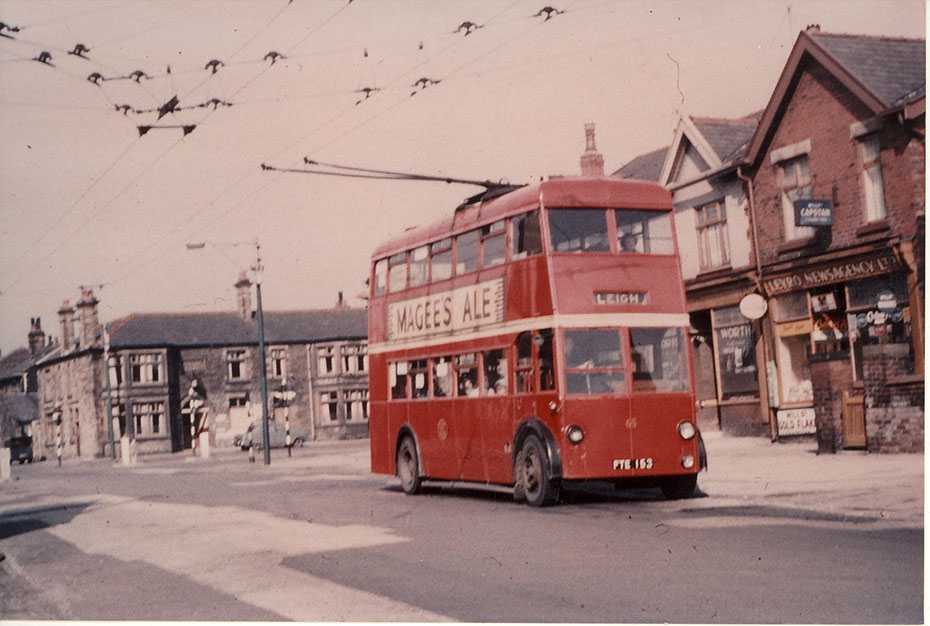
SLT trolleybus at Four Lane Ends, between Bolton and Atherton
1955 Use of fibreglass for vehicle wings and panels to reduce accident damage for the first time.
1955 Manchester Corporation withdraws Bell Punch ticket machines.
1956 Suez crisis and consequent fuel rationing. Extra trolleybuses run, greater demand for public transport.
1956 First trolleybus route converted to buses by SLT (11 November).
1956 British Railways introduces a frequent diesel service into Manchester from Ramsbottom, causing a fall in bus passenger numbers.
1956 Oldham Corporation introduces 'Setright' ticket machines.
1958 New bus station at Chorlton Street opened by Manchester Corporation.
1958 Last South Lancashire Transport Company (SLT) trolleybus runs (31 August). SLT is closed and is incorporated into LUT (1 September). Buses replace the trolleybuses and are operated by Bolton and Leigh corporations and LUT.
1958 Traffic flow around Piccadilly area in Manchester revised, causing large rearrangement of bus stopping places.
1958 Leigh Corporation becomes the first undertaking to operate the new Dennis Loline type of bus (September).
1958 Manchester Corporation introduces spray painting of its buses instead of hand painting, for the first time.
1958 Official opening of the new Piccadilly Bus Station, by Manchester Corporation (4th December).
1958 Wigan Corporation extends its motorbus garage (December).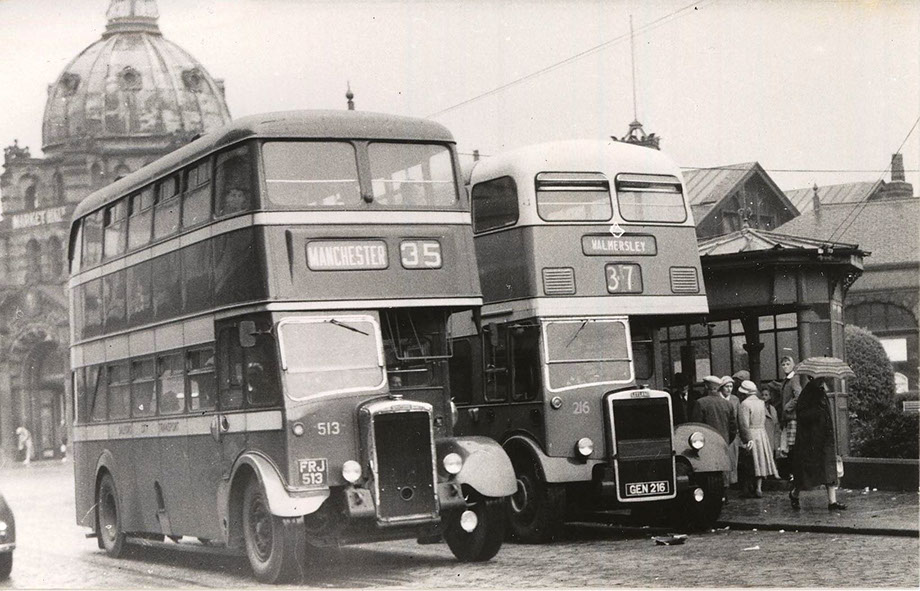
Kay Gardens in Bury, showing the old Market Hall in the background with newly delivered 216 from Bury Corporation

Typical 1960s street scene showing a municipal bus (SHMD) and terraced houses in the days before traffic congestion becomes a major problem
1960 The first rear engined double deck Leyland Atlantean buses enter service for Manchester Corporation.
1960 SHMD opens Hyde Bus Station (1 July).
1960 Manchester Corporation introduces Setright ticket machines.
1961 Manchester Corporation introduces the City Circle service linking key areas of the city centre – it uses one-man operated buses (20th June).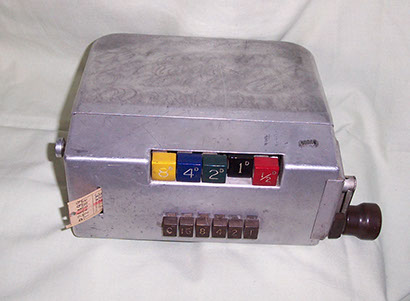
A new 'Creed' ticket machine is developed. It records ticket sales by punching holes into a paper tape. Data from the tape is 'read' by a device which automatically prints ticket sale totals and statistics.
1962 Transport Act 1962: reorganisation of nationalised transport undertakings - creation of the British Railways Board (1 August).
1962 Salford Corporation trials its first rear-engined buses.
1962 Bury, Manchester and Oldham corporations trial new 'Creed' ticket machines.
1963 Manchester Corporation trials a London Transport Routemaster (RM 1414) in service, operating from Parrs Wood Garage for one month (February)
1963 The new Manchester Corporation head office opens on Devonshire Street North by the Minister of Transport – it replaces 55 Piccadilly in Manchester, the head office since tramways days (22nd March).
1963 The Reshaping of British Railways (Beeching Report) is published which proposes drastic cuts to Greater Manchester’s railway network (27 March).
1963 Bolton and Bury corporations introduce rear-engined buses for the first time.
1964 Bury Corporation tries two Setright ticket machines.
1964 Ashton-under-Lyne Corporation opens its central bus station (6 November).
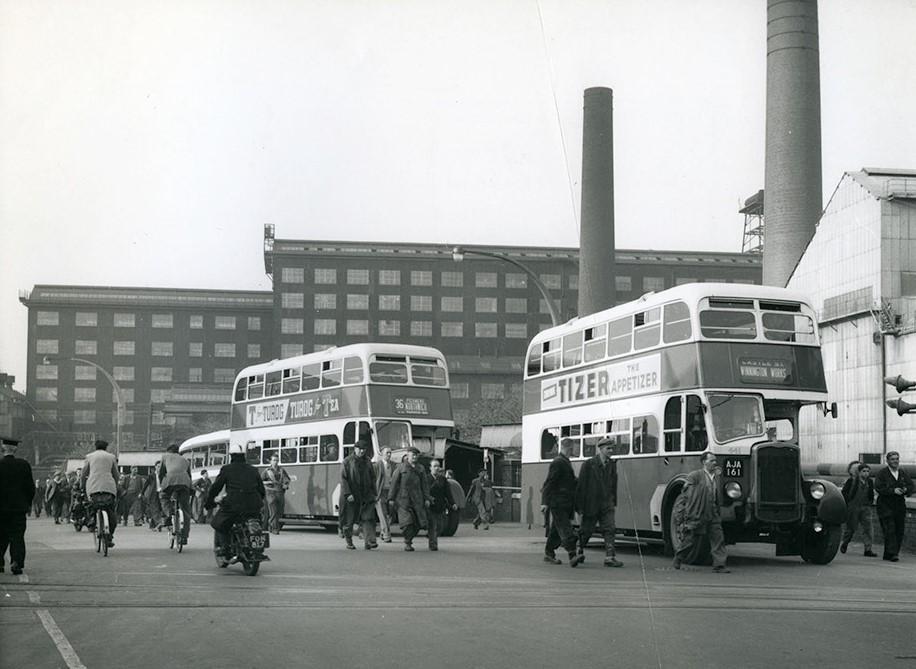
North Western works buses in 1962 getting ready to take people home
1965 Manchester Corporation introduces concessionary fares for elderly people for the first time (2nd May).
1965 Manchester Corporation withdraws its City Circle service (17th September).
1965 Automated passenger operated ticket machines introduced by Manchester Corporation, known as "Minimax" (18th October).
1966 The first White Paper proposes the establishment of multi-purpose conurbation authorities to have complete control of transport policy in their designated areas (July).
1966 Manchester Corporation decides that one-man buses should be introduced throughout its system (3 August).
1966 SHMD starts to operate its buses along former trolleybus routes.
1966 A feasibility report is prepared, considering a rapid transit system for Manchester.
1966 Manchester Corporation withdraws TIM and ‘Ultimate’ ticket machines.
1966 Bury Corporation converts to Setright ticket machines.
1966 Last trolleybuses run in Greater Manchester, operated by Ashton-under-Lyne and Manchester corporations (31 December).
1967 Manchester Corporation rolls out a simplified fare structure to facilitate the introduction of one-man operated buses to save time now the driver was handling fares instead of a conductor (1st July).
1967 The first one-man double deck bus service is started by Manchester Corporation (14 August).
1967 The White Paper “Public Transport and Traffic” proposes the creation of a Passenger Transport Authority for South East Lancashire and North East Cheshire (which now forms most of Greater Manchester) which would take complete control for all bus and rail services in the conurbation (December).
1968 A new design of bus for Manchester City Transport is introduced, known as the Mancunian (1st April).
1968 BET sells out to the Transport Holding Company and North Western Road Car Company becomes part of the nationalised bus fleet.
1968 Experiments commence by Manchester Corporation with "Johnson" fareboxes where no tickets are issued, to try to speed up passenger boarding times (19th August).
1968 The Transport Act 1968, which is to establish a Passenger Transport Authority for South East Lancashire and North East Cheshire (SELNEC). The SELNEC Area will include 2.5 million people and 700-800 square miles. It will be one of four Authorities entrusted with the responsibility for co-ordinating public transport in the conurbations (25 October).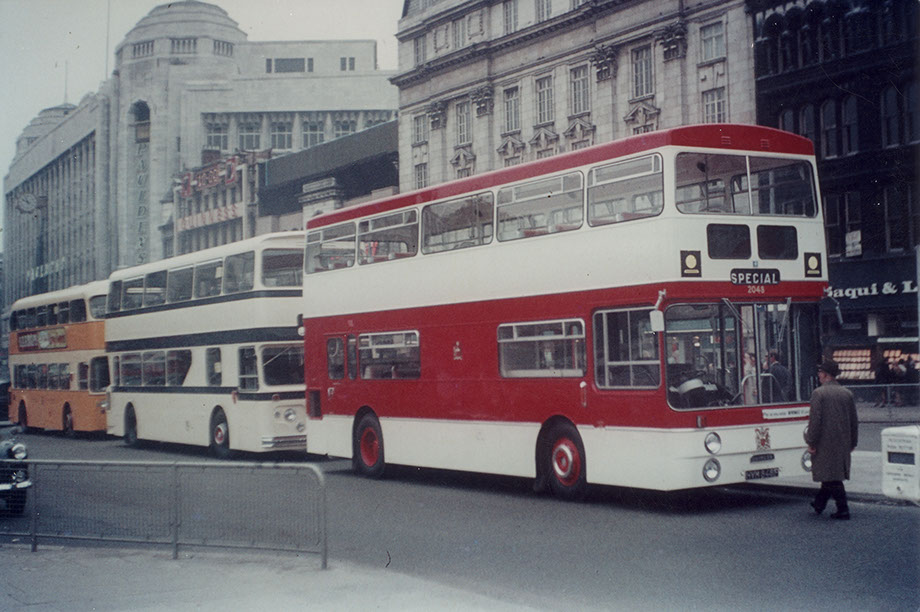
Manchester asks the public its views on the new bus for Manchester, compared with new buses for other towns (Sheffield and Newcastle) in 1968
